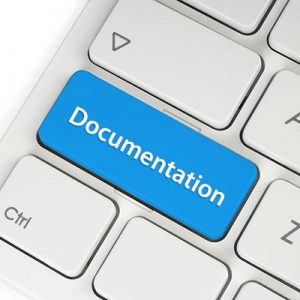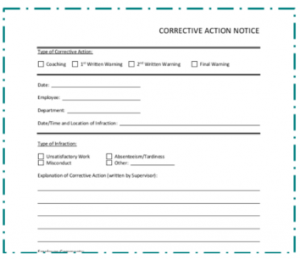Coaching & Corrective Action Series
CCA Documentation
(Part 3 of 3 Part Series)
By Sarah Zasso, SHRM-SCP, SPHR
In Part 1 and 2 of this series, we discussed Coaching and having the STU. To close this series, I would like to share with you how to document Coaching and Corrective Actions (CCA’s).
What is Documentation?
Documentation is when you make a written record of any Coaching and Corrective Action that is delivered to an employee. This includes the Corrective Action Notice (see sample portion below) and any documents that support the CA. Supporting documents can include: Time cards, attendance records, emails, witness statements, investigation reports, etc.
Why is it Important Legally?
According to Employment Attorneys Nexsen Pruet, “An accurate record of performance problems greatly assists employers (and their counsel) in defending decisions to take disciplinary action based on poor performance when that employee later complains that a decision was unfair, illegal, or discriminatory.” Not only does documentation help protect the employer legally, but it can also help ensure that your policies are consistently applied throughout your company, which is critical from a discrimination standpoint. Documentation is also helpful if you choose to contest an unemployment claim.
In my past roles, I would often have a manager come to me to discuss terminating an employee. Here is how the conversation would typically go (abbreviated):
Manager: I want to fire Ursula Underperformer!
Me: Have you spoken with her? Have you warned her that she could be terminated if she did not improve her performance?
Manager: Of course, YES!
Me: May I see your documentation please?
Manager: …
Me: …
Manager: [mumbling] I don’t have any.
Me: Hmmm.
Manager: But, it happened! And she needs to go!
Me: I’m sorry, but if you don’t have documentation, it’s as if those conversations didn’t happen. Terminating her without documentation would put the company at risk. And it’s not fair to the employee. I would suggest you restart the CCA process with her today. And make sure you document!
When an employer takes employment action, without documentation – not only is it wrong not to give the employee an opportunity to succeed, but it can put the company at significant legal risk.
What Should You Write in a CCA?
There are several components that should be included in a CCA documentation:
- Date and description of incident
- How this affected the company
- Policy that was violated
- Expectations going forward
- Consequences for failing to meet expectations
Below are some examples:
“Charlie Callout, we coached you on 1/15/17 about your attendance and you were placed on a written warning on 2/20/17. As of today, 4/15/17, we have not seen a significant and sustained improvement in your attendance (see attached attendance record). Your attendance has caused customer service issues (resulting in customer complaints) and has forced additional workload on other employees. This is a violation of our attendance policy and it will not be tolerated. Going forward, you are expected to report for your scheduled shifts, on time and work your complete shift. You are being placed on a Final Warning. Future occurrences may result in additional corrective action, up to and including termination.”
“Debbie Damage, on 7/1/17, you were observed improperly operating a forklift. Specifically, you were operating the forklift at an unsafe speed and almost hit shelving units. This could have caused injury to yourself or others, and damage to company property. This type of behavior is unacceptable and is a violation of our Safety and Standards of Conduct policies. Going forward, you are expected to operate the forklift in a safe manner and follow all government and company guidelines. You are being placed on a Final Warning. Future occurrences may result in additional corrective action, up to and including termination.”
CCA Pointers
- CCA documentation should be factual, with no emotions.
- Be concise on the corrective action form. If the documentation requires a thorough explanation, you can provide a detailed summary of events along with the CCA. [Note: Some companies write a CCA letter that includes the above, as well as a more thorough explanation of the situation, expectations, etc. That is fine too.]
- Employee does not have to sign a CCA. If they refuse, simply write “Refused to Sign.” Remind them – they are signing to acknowledge receipt and understanding, not agreement.
- I recommend sending a detailed follow up email to the employee, summarizing the conversation and expectations going forward. (not necessary in all situations, more typical for performance issues or those that refused to sign)
- I also recommend documenting the actual CCA conversation for your records.
- A coaching should be documented, but the employee does not usually sign. You are simply documenting the conversation for your records.
- Depending on the seriousness of the offense, you may skip CCA steps. The documentation is similar for all steps.
- On the CCA or supporting documentation, note the date of the meetings and those in attendance.
Final Thoughts
The purpose of CCA and documentation is not simply to protect an employer from a lawsuit. The true intent is to show the employee that you are doing everything you can to help them become successful in their role. COACH and CORRECT the behavior (i.e. Coaching and Corrective Action). The importance of documentation not only shows the employee that you take their success seriously, but allows the employer a more defensible position in the event of a lawsuit.
Remember:
This article is for general information purposes only. I am not an attorney; accordingly, the information presented is not legal advice, and is not to be acted on as such.
About the Author
Sarah Zasso is the Owner/Principal HR Consultant of Sabeza HR (www.SabezaHR.com), a Human Resources Consulting company. Sarah has achieved both the SHRM-SCP and SPHR certifications and earned a Bachelor’s degree in Organizational Leadership and Communication. With almost 15 years of Human Resource experience, she has worked with a wide variety of industries including retail, restaurant, office, manufacturing, banking, hospitality, and healthcare. Sarah has served on the board of the SHRM affiliated Coastal Organization of Human Resources since 2015 and has been elected President for 2017. Sarah is a highly focused and energetic Human Resources professional, and prides herself on her integrity, passion, and positive nature. Sarah is dedicated to meeting and exceeding client’s expectations.
Sabeza HR is “Your Human Resources Solution.” For a free consultation, contact me at [email protected], 843-691-9092.









